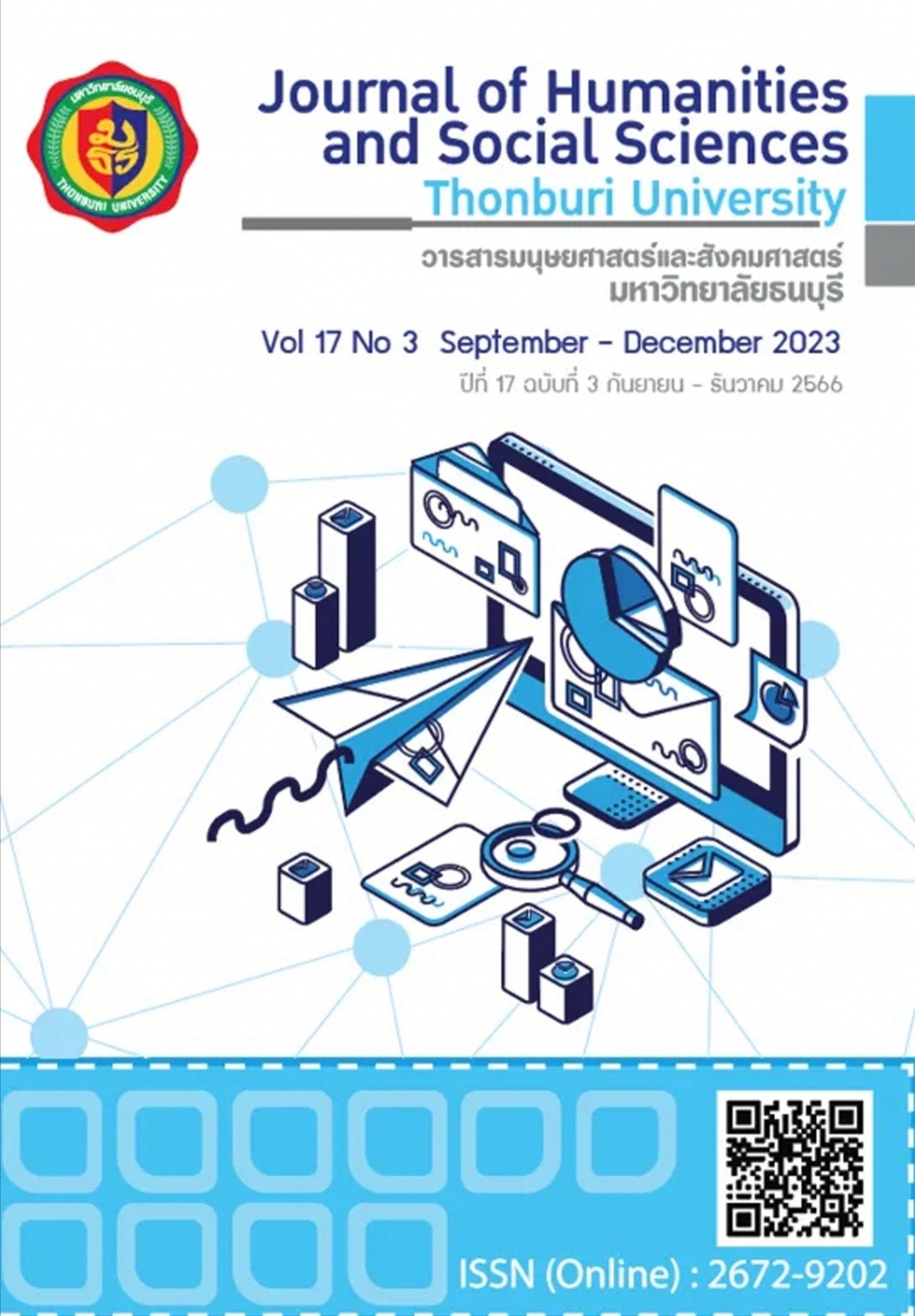A Policy Analysis of Developing and Strengthening Thailand’s Local Economy Through the One-Tambon-One-Product Project (OTOP)
Keywords:
Public Policy, Local Economy, Local Development, One-Tambon-One-Product (OTOP) ProjectAbstract
This academic article was aimed at examining the public policy on developing and strengthening the local economy through the one-tambon-one-product (OTOP) project, comparing the policy implementation of Thailand’s OTOP and Japan’s OVOP, and presenting innovative policies on developing Thailand’s local economy through the OTOP project. The results indicated that the OTOP project was adopted as a tool to narrow the gap of income inequalities between urban and rural areas. However, the government failed to achieve the OTOP’s goals of increasing the sales revenues of OTOP products at least 30 percent annually starting from 2018 – 2022. The results of comparing the implementation of the policy on developing local economy between OTOP’s Thailand and OVOP’s Japan indicated that the Thai government played an active role in driving the OTOP project while the Japanese government served as a supporting role in facilitating the OVOP movement. As far as innovative policy recommendation was concerned, both demand and supply should be equally emphasized. For the demand side, market research was highly recommended to analyze the needs of consumers; as a result, the products that satisfied those needs could be identified and developed. For the supply side, product differentiation strategy should be employed to serve as a guideline for direction of the OTOP products’ development.
References
ประเวศ วะสี. (2558). วิธีการและกลไกลยุทธศาสตร์ประชารัฐสร้างความเข้มแข็งเศรษฐกิจฐนรากบนหลักการเศรษฐกิจพอเพียง. นนทบุรี: หมอชาวบ้าน.
สำนักงานสภาพัฒนาการเศรษฐกิจและสังคมแห่งชาติ. (2562). แผนแม่บทภายใต้ยุทธศาสตร์ชาติ (2561-2580). กรุงเทพฯ: สำนักงานสภาพัฒนาการเศรษฐกิจและสังคมแห่งชาติ.
สำนักงานสภาพัฒนาการเศรษฐกิจและสังคมแห่งชาติ (2564). รายงานวิเคราะห์สถานการณ์ความยากจนและความเหลื่อมล้ำของประเทศไทย ปี 2564. สืบค้นเมื่อ 2 มกราคม 2566, จาก https://www.nesdc.go.th/ewt_dl_ link.php?nid=13081
Ariyaarpakamol, N. (2019 ). Urban-Rural Inequality in Thailand: Differences in Characteristics or Returns? . Kasetsart Journal of Social Sciences, 32-39.
Bundi, P., & Trein, P. (2022). Evaluation Use and Learning in Public Policy. Policy Sciences, 55, 283-309.
Chukwurah, D. C., Nduba, O. D., & Obinna, M. (2020). The Role of Impact Evaluation on Policy Implementation in Nigeria. International Journal of Academic Accounting, Finance & Management Research, 4(8), 135-140.
Claymone, Y., Jaiborisudhi, W., & Chotisut, K. (2019). An Analysis of One Tambon One Product (OTOP) Project: Problems, Obstacles, Achievements. International Journal of East Asian Studies, 23(2), 172-192.
Chotikhamjorn, S. (2022). Study of Income Inequality in Thailand. Journal of Roi Et Rajabhat University, 16(2), 210-218.
Curry, R., & Sura, K. (2007). Human Resource Development (HRD) Theory and Thailand’s Sufficiency Economy Concept and Its Program. Journal of Third World Studies, 24(2), 85-94.
Filgueiras, F., & Queiroz, L. d. (2021). The Governance of Public Policy Evaluation Systems: Policy Effectiveness and Accountability. Journal Organizações & Sociedade, 28(96), 208-232.
Furuoka, F., Lim, B., Jikunan, C., & Chiun, L. M. (2012). Economic Crisis and Response: Case Study of Malaysia's Responses to Asian Financial Crisis. Journal of Contemporary Eastern Asia, 11(1), 43-56.
Igusa, K. (2008). The Problem of the Regional Revitalization in Asia and One Village One Product: Adaptability of Oita Model to Asian Countris. Journal of OVOP Policy, 1. October 2008.
Knight, J. (1994). Rural Revitalization in Japan: Spirit of the Village and Taste of the Country. Asian Survey, 34(7), 634-646.
Kurokawa, K. (2009). Effectiveness and Limitations of the One Village One Product (OVOP) Approach as a Government-Led Development Policy: Evidence from Thai One Tambon One Product (OTOP). Studies in Regional Science, 39(4), 977-989.
Natsuda, K., Igusa, K. Wiboonpongse, A., Cheamphan, A., Shingkharat, S., & Thoburn, J. (2011). One Village One Product -Rural Development Strategy in Asia: The Case of OTOP Thailand. Oita: Ritsumeikan Center for Asia Pacific Studies (RCAPS).
Pornsuttichaipong, P. A., Srichad, P. A., & Phutchu, P. S. (2022). Strengthening Economic Foundations to Enhance the Economy, Society and to Secure Income. Journal of Arts Management, 6(2), 932-948.
Raimondo, E. (2018). The Power and Dysfunctions of Evaluation Systems in International Organizations. Evaluation, 24(1), 26-41
Roadkaew, K., Senanuch, P., & Jundai, R. (2021). Research on Opinions on Sustainable Grassroot Economic Development Policy. King Prajadhipok's Institute, 48-66.
Theodoulou, S. Z., & Kofinis, C. (2004). The Art of the Game: Understanding American Public Policy Making. Belmont, CA: Wadsworth.
Thu, N. T. (2013). One Village One Product (OVOP) in Japan to One Tambon One Product (OTOP) in Thailand: Lessons for Grass Root Development in Developing Countries. Journal of Social and Development Sciences, 4(1), 529-537.
Wang, H. (1999). The Asian Financial Crisis and Financial Reforms in China. The Pacific Review, 12(4), 537-556.
Widiyanti, A. (2018). A Comparative Study: One Village One Product (OVOP) as an Engine of Local Economic Development in Japan and Indonesia. Jurnal Litbang Sukowati, 1(2), 80-94.
WorldBank. (2022, October 21). Rural Thailand Faces the Largest Poverty Challenges with High Income Inequality. Retrieved from WorldBank: https://www.worldbank.org/en/news/press-release/2022/10/21/rural-thailand-faces-the-largest-poverty-challenges-with-high-income-inequality
Translated Thai References
Office of the National Economic and Social Development Board. (2019). Thailand's National Strategy 2018 - 2037. Bangkok: Office of the National Economic and Social Development Board. (in Thai)
Office of the National Economic and Social Development Board. (2021). Poverty and Inequality Report 2021. Retrieved from https://www.nesdc.go.th/ewt_dl_link.php?nid=13081 (in Thai)
Prawet Wasi. (2015). Thai People's Methods and Strategic Mechanism to Strengthen Local Economy Based on Sufficiency Economy. Nonthaburi. Morchoaban.
Downloads
Published
How to Cite
Issue
Section
License
Copyright (c) 2023 Aumphorn Jindarat, Samita Temphoemphoon

This work is licensed under a Creative Commons Attribution-NonCommercial-NoDerivatives 4.0 International License.
ผลงานที่ปรากฎในวารสารฉบับนี้เป็นลิขสิทธิ์เฉพาะส่วนบุคคลของผู้เขียนซึ่งต้องรับผิดชอบต่อผลทาง กฎหมายที่อาจเกิดขึ้นได้และไม่มีผลต่อกองบรรณาธิการ






